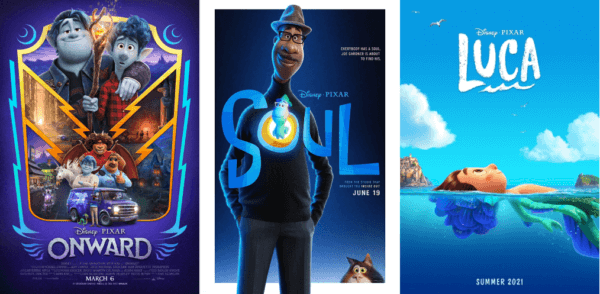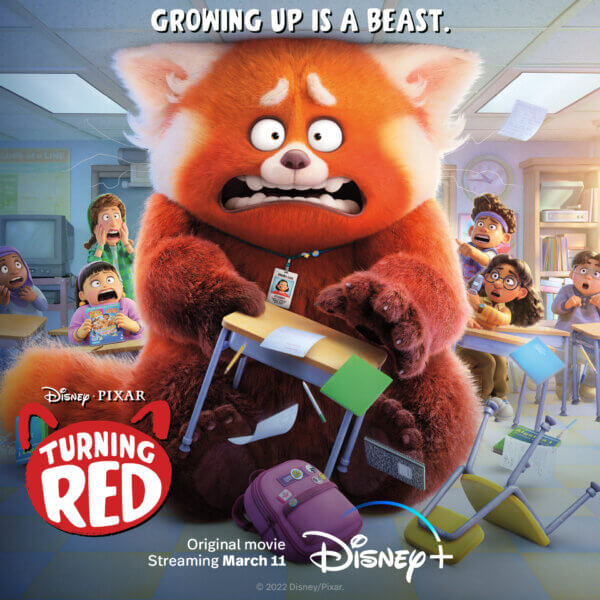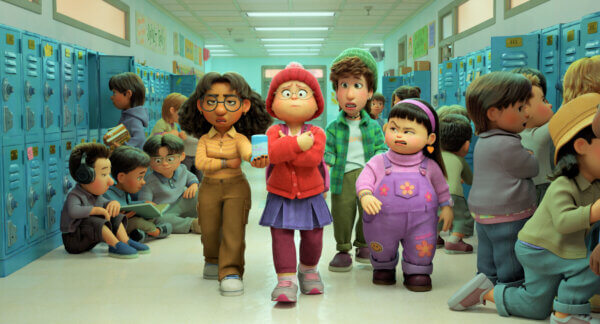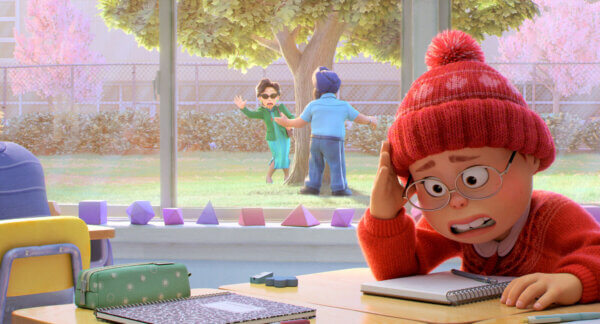Is Turning Red Set to Turn the Tide for Pixar?
In 1995 a fresh faced, relatively unknown animation studio released a feature film with the help of Walt Disney Pictures about toys that came to life. The result was a worldwide sensation, a film that audiences marvelled at, that boasted a never before seen CGI technique, a heartfelt story and memorable characters. Landing onto a landscape of 2D films telling similar stories, cinema goers were delighted to see a fresh perspective in animated filmmaking.
The success of Toy Story would help project Pixar through decades of innovative filmmaking and established an audience hungry for more films from them. In spite of their dominance it’s often said that, on the surface at least, the Pixar films are rather formulaic. We’ve all seen the memes that dig at Pixar’s tried and tested storytelling formula – ‘What if Toys had feelings’, ‘what if fish had feelings’ what if feelings had feelings’. Whilst other studios have tried to imitate Pixar’s ‘what if’ formula, a lot of them tend to neglect the ‘feelings’ side of things and rarely have made the same universal impression that has kept the Emeryville based animation house dominant.

Pixar’s Emeryville Studio (Pixar.com)
In spite of the blockbusters, the fresh storytelling at Pixar seems to have slowed down in the 2010’s to make way for sequels, with over half of the features released in that decade returning to the characters and stories we’ve seen before. Whilst it is nice to revisit the universes that Pixar craft, the joy of Pixar films is revelling in new universes. The 2020’s have seen a stop to the sequels at least with brand new worlds and topics to tackle. Onward brought us a story of struggling with grief and self confidence set in an adventurous world where myth has become mundane. Soul shared a body swap tale of pursuing your dreams set against one of the biggest questions humanity has yet to answer and Luca basked in the sunshine of childhood nostalgia as a young sea monster wished to explore the world beyond the sea.
Whilst these films were undoubtably enjoyable, they failed to capture the lightning in a bottle that the early Pixar films did. They stayed fixed to a formula that most American CG family features tend to fall for – a reliance on men. How many more CGI family films do we need to see about a male character who has to overcome some kind of personality hurdle in order to become a better person? We’ve seen toys, we’ve seen superheroes, we’ve seen bugs, we’ve seen fish, cars, rodents, robots, old men, young men, monsters and dinosaurs and when we think we’ve seen every possible iteration of the male story we are greeted with elves, souls and sea monsters.

Pixar’s recent film offerings have seen them stray away from sequels but stick to a largely male centric storytelling dynamic with Onward (2020), Soul (2020) and Luca (2021) all released in recent years.
Whilst Pixar undoubtably have some fantastic female characters in their back catalogue, the prospect of Turning Red, with a female centric storyline is a very welcome one. To be fair to the studio it’ is not the first time they have told a story from the female point of view. In Turning Red we have a film about a mother daughter relationship, set outside of American culture, where one of them turns into a big bear. Where have we seen that type of Brave storytelling before I hear you ask? Okay let’s slow down with the sarcasm. Brave was stuck in a quagmire of production issues, with the then studio head seemingly reluctant to allow Director Brenda Chapman to tell her own story, assigning Mark Andrews to turn what would have been a story reflecting on Chapman’s mother-daughter relationship called The Bear and the Bow into Brave, another princess movie in the Disney tradition, barely troubling the status quo beyond being declared as the first Pixar princess movie.
Thankfully, there is no sign of these issues with Turning Red in fact, with it’s all female leadership team covering direction, writing, production and technical aspects of the film and a storyline that embraces the nuances of a mother daughter relationship and the emotional and physical challenges that puberty can inflict, as Director Domee Shi (Academy Award winner for the Pixar short Bao) says “we want to use the red panda in this movie as an adorable metaphor for the scary, unadorable, awkward, and cringy, uh, changes we go through during this age.”

Domee Shi has been able to tell a story unencumbered by the challenges Chapman had to endure and is clearly championed by the new management at Pixar. And it appears to have worked, no doubt leaving many to wonder why it would have been such a gamble to tell a story like this in the past. The team have not only embraced the family aspect, but also a cultural aspect, delivering what Shi refers to as an “Asian tween fever dream” in telling the story of Mei Lee, a high achieving, Asian-Canadian girl, living in Toronto in the early 2000’s, obsessed with boybands, but torn between family loyalty and friendship. To throw a bigger spanner in the works, a family curse turns her into a giant red panda whenever she gets emotional. The early millennium setting setting itself helps to tell the story as Shi states “we wanted to avoid social media, uh, topics and just kind of tell this story in a simpler time of flip phones, CDs, jelly bracelets, and Tamagotchis.” There is a palatable excitement for the release of Turning Red from an awaiting audience wanting to see stories like this being told. The success of the Katie driven Mitchells vs the Machines has perhaps opened up Hollywood animations mind to the possibility of telling stories that centre around the female perspective.

MIDDLE SCHOOL MAYHEM – In Disney and Pixar’s all-new original feature film “Turning Red,” 13-year-old Mei Lee, a confident-but-dorky teenager, is surviving the mayhem of middle school with a little help from her tightknit group of friends. Featuring the voices of (from left to right) Maitreyi Ramakrishnan as Priya, Rosalie Chiang as Mei, Ava Morse as Miriam, and Hyein Park as Abby, “Turning Red” will debut exclusively on Disney+ (where Disney+ is available) on March 11, 2022. © 2022 Disney/Pixar. All Rights Reserved.
Turning Red isn’t just changing the way Pixar are telling stories, but also stylistically how they are making films, with an innovative blend of eastern anime and western influences that the director adores, being filtered through the Pixar team, as Patty Kihm, animation supervisor states “One of the great things about anime is that it’s not afraid to push the characters’ designs to the extreme. Domee had a really strong design sense. She would give us drawings for how the characters should look. You can see how we used the moon-shaped eyes and cat mouths.” The simple character designs with the ‘bean mouth’ allow for great expression and the dynamic animation, on top of this the lighting team have added extra effort to make the film pop. From the general fuchsia fuzz that the film exudes, through to the hilarious fast zooms that light the characters like a horror movie to add to the comedy of the film. The colour language is also worth noting, with clashes of red and green to highlight the dynamic between mother and daughter.

MOTHER’S NATURE – In Disney and Pixar’s all-new original feature film “Turning Red,” confident-but-dorky teenager Mei Lee is torn between staying her mother’s dutiful daughter and the chaos of adolescence. And Mei Lee’s mother has very strong feelings about it all. Featuring Rosalie Chiang as the voice of Mei Lee, and Sandra Oh as the voice of Mei Lee’s mother, Ming, “Turning Red” will debut exclusively on Disney+ (where Disney+ is available) on March 11, 2022. © 2022 Disney/Pixar. All Rights Reserved.
It’s clear with studios such as Sony Pictures releasing work such as Into the Spider-Verse and Mitchells vs The Machines, breaking the traditionally held notion of what an animated feature is allowed to do, Pixar had to step up it’s offer. What the studio has done with Turning Red is to allow the Director to apply their own personality to the film and in doing so they have opened up a whole new era of possibilities for the studio with the possibility of them telling stories that connect with audiences of the 2020s with much the same spark that Toy Story did in the 1990s. Let’s hope that they follow the trend and we begin to see more American animated feature stories with fresh perspectives once again.
Turning Red streams on Disney Plus from the 11 March 2022. Keep your eyes on Skwigly for future coverage on the film.

